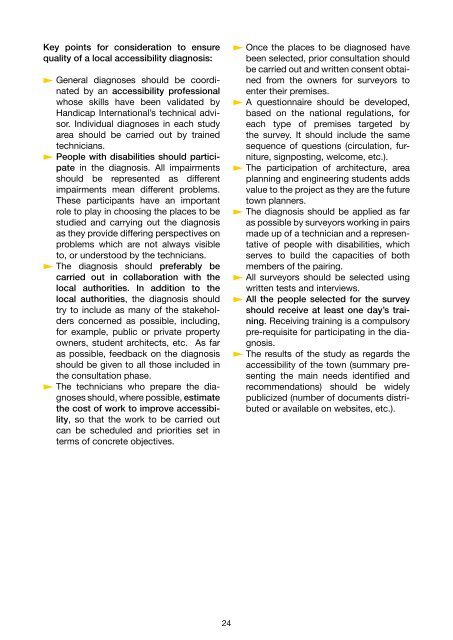Accessibility - Handicap International
Accessibility - Handicap International
Accessibility - Handicap International
You also want an ePaper? Increase the reach of your titles
YUMPU automatically turns print PDFs into web optimized ePapers that Google loves.
Key points for consideration to ensure<br />
quality of a local accessibility diagnosis:<br />
/ General diagnoses should be coordinated<br />
by an accessibility professional<br />
whose skills have been validated by<br />
<strong>Handicap</strong> <strong>International</strong>’s technical advisor.<br />
Individual diagnoses in each study<br />
area should be carried out by trained<br />
technicians.<br />
/ People with disabilities should participate<br />
in the diagnosis. All impairments<br />
should be represented as different<br />
impairments mean different problems.<br />
These participants have an important<br />
role to play in choosing the places to be<br />
studied and carrying out the diagnosis<br />
as they provide differing perspectives on<br />
problems which are not always visible<br />
to, or understood by the technicians.<br />
/ The diagnosis should preferably be<br />
carried out in collaboration with the<br />
local authorities. In addition to the<br />
local authorities, the diagnosis should<br />
try to include as many of the stakeholders<br />
concerned as possible, including,<br />
for example, public or private property<br />
owners, student architects, etc. As far<br />
as possible, feedback on the diagnosis<br />
should be given to all those included in<br />
the consultation phase.<br />
/ The technicians who prepare the diagnoses<br />
should, where possible, estimate<br />
the cost of work to improve accessibility,<br />
so that the work to be carried out<br />
can be scheduled and priorities set in<br />
terms of concrete objectives.<br />
/ Once the places to be diagnosed have<br />
been selected, prior consultation should<br />
be carried out and written consent obtained<br />
from the owners for surveyors to<br />
enter their premises.<br />
/ A questionnaire should be developed,<br />
based on the national regulations, for<br />
each type of premises targeted by<br />
the survey. It should include the same<br />
sequence of questions (circulation, furniture,<br />
signposting, welcome, etc.).<br />
/ The participation of architecture, area<br />
planning and engineering students adds<br />
value to the project as they are the future<br />
town planners.<br />
/ The diagnosis should be applied as far<br />
as possible by surveyors working in pairs<br />
made up of a technician and a representative<br />
of people with disabilities, which<br />
serves to build the capacities of both<br />
members of the pairing.<br />
/ All surveyors should be selected using<br />
written tests and interviews.<br />
/ All the people selected for the survey<br />
should receive at least one day’s training.<br />
Receiving training is a compulsory<br />
pre-requisite for participating in the diagnosis.<br />
/ The results of the study as regards the<br />
accessibility of the town (summary presenting<br />
the main needs identified and<br />
recommendations) should be widely<br />
publicized (number of documents distributed<br />
or available on websites, etc.).<br />
24

















